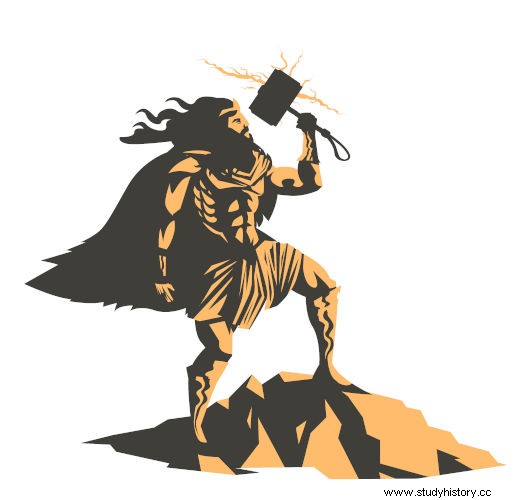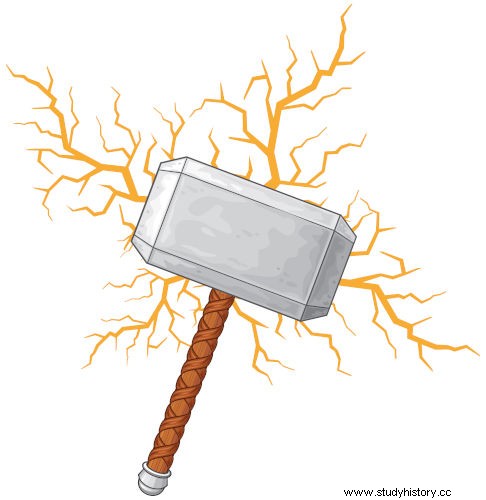
Thor he was an important god who was part of the religiosity of the Norse, being considered the most popular deity among the Vikings (Nordic during the Viking Age). He was known as the god of thunder and his great symbol was his hammer, known as Mjölnir. Thor's ultimate fate would be to fight a giant serpent during Ragnarök.
Go to also :How did the Vikings view war?
Thor Summary
-
Thor was the most popular god among the Norse.
-
It originated in Germanic culture and was known to Germans as Donar.
-
he was the god of thunder, storm and agriculture.
-
His great symbol of him was his hammer Mjölnir.
-
During Ragnarök, Thor would fight the giant serpent Jörmungandr, who would be killed, but not before fatally poisoning him.
Who was Thor?
Thor is known as one of the religious gods of the Norse, people who inhabited the north of the European continent. Devotion to him reached its most expressive moment during the period known as the Age Viking , which spanned from 793 to 1066, when Norse (or Viking) navigations took place.
Thor was the most popular deity among the Vikings and known to be the god from thunder , da storm and da agriculture . He was very popular, especially among the peasant strata that formed Nordic society. He was seen as the god responsible for protecting Midgard, the middle land where humans lived.
As a result, Thor was also seen as a protector da humanity . He was son of Odin , the supreme god of Norse religiosity, and of Jörd, considered the personification of Earth in that religion. Another very important fame of his was that of killer from giants, and a number of passages from Norse mythology underscore this attribute.
Thor was a deity from Germanic culture and known as Donar among the Germanic peoples. Donar was also regarded as the god of thunder, and historians have traced similarities between him and the gods of other cultures, such as Taranis, of the Celts, and Perkunos, worshiped in the Baltic region.
Thor was known for his strength, and this was reflected in his fame as a giant slayer. His strength was increased by some accessories he used in his fights. The first accessory was his hammer Mjolnir; the second was the belt Megingjord , which doubled the strength of its owner; and the third accessory was the gloves Járn g lófar , necessary for him to hold the hammer.
Thor is also known to have married twice, his first wife being the giantess Járnsaxa and his second wife was the goddess Sif , seen as someone who brought fertility to agriculture. From their marriages four children were born:Modi , Magni , Lorride and Thrúd .
Read more :Germanic Invasions — the mixing of Germanic and Latin culture gave origin of western culture
Thor in Norse Religion

We mentioned the fact that Thor was the most popular god among the Norse during the Viking Age. His popularity was very high among the peasant classes, formed by the karls , that is, free men. Even so, the importance of this deity was perceived in different levels of Nordic social relations.
Business Agreements and Marriages they were confirmed through prayers to Thor; the Norse populace used to invoke his name to ensure their protection in battle, on sea voyages , or even so that good harvests were achieved. The Norse also identified it with natural phenomena such as thunder.
A phenomenon already identified by historians was that, in the Viking Age, the use of pendants became quite common. with the format d the hammer Mjolnir as a symbol of faith to Thor. It was found that this act was a kind of public demonstration of faith and that it became common with the advance of Christianity among the Norse from the 11th century onwards.
-
Vikings Video Lesson
Thor in Ragnarök
Thor's many feats are chronicled in a series of myths recorded by the Icelandic historian Snorri Sturluson, who lived in the 12th and 13th centuries. It is through these myths that we know of Thor's fights (and victories) with different giants. However, the great fight of this god would not have been with giants, but with a serpent giant .
This snake was called Jörmungandr and known for being the daughter of Loki, a being from Norse mythology quite controversial because some historians understand him as a god, but others only as a giant who lived among gods. Loki's children were the fruit of his relationship with the giant Angrboda.
Jörmungandr and other Children of Loki (Hel and Fenrir) were understood in Norse mythology as bearers from chaos and would play important roles in the destruction of the Universe during Ragnarök. Jörmungandr was a giant serpent that resided in the ocean, and it was so large that its body circled the planet and its head reached its tail.
In Norse mythology, the definitive meeting between Thor and the serpent would take place at Ragnarök, a catastrophic event that would lead to the destruction of the Universe and some of the gods of the Norse pantheon. From that event, the Universe and humanity would be formed anew with some of the gods that would survive it.
During Ragnarök, a final battle would take place in a place known as the "Plain of Vigrid". There, Thor would fight the giant serpent and use his strength to kill it , but a few steps later, would fall dead , having been poisoned by the serpent. If you are more interested in the topic of the topic, read:How did the vikings believe the end of the world would be?
